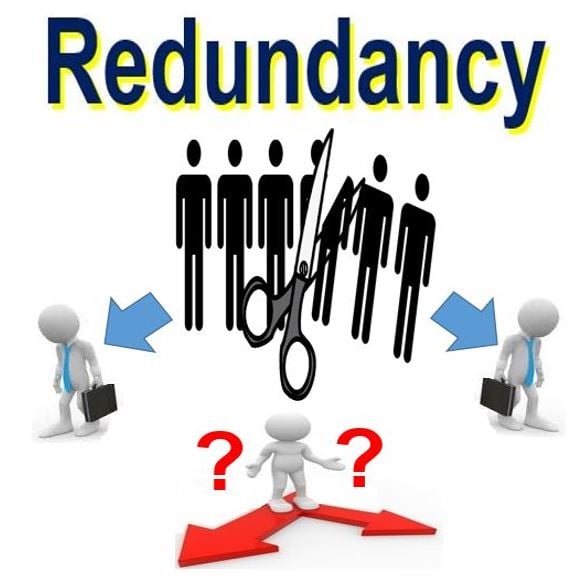Small Business Closing Employee Rights UK: Making Sure Fair Redundancy Pay
Wiki Article
Exploring the Operational Characteristics of Firm Redundancy and Its Long-Term Sustainability

Redundancy Strategies for Service Continuity
In order to make certain continuous procedures, companies have to implement efficient redundancy approaches for company continuity. Redundancy in this context describes the replication of crucial parts or features within a system to reduce the effect of possible failings. By incorporating redundancy techniques, companies can boost their resilience against disturbances triggered by different variables such as natural disasters, devices failings, or cyber-attacks.
One typical redundancy approach is the implementation of backup systems and data storage options. This entails developing duplicates of important information and systems that can be turned on in instance of a key system failing. In addition, companies can develop repetitive interaction networks and power sources to maintain connectivity and operations throughout unpredicted events.
Moreover, cross-training staff members to perform several functions within the business can act as a valuable redundancy technique. If key personnel are unavailable due to ailment or various other factors, this makes sure that vital tasks can still be carried out also. Generally, efficient redundancy techniques are important for businesses to promote functional continuity and minimize the influence of prospective disruptions.
Impact of Redundancy on Business Strength
Offered the essential duty redundancy methods play in making certain service continuity, checking out the effect of redundancy on organizational durability becomes critical for recognizing the all natural functional characteristics of a company. Business durability describes an entity's ability to adjust to disruptions, recoup from problems, and change when needed while maintaining core functions. Redundancy, when purposefully executed, can considerably contribute to improving an organization's durability in the face of unforeseen obstacles. By having back-up systems, workers, or procedures in location, firms can better stand up to shocks and continue operations with very little disruption.Furthermore, redundancy can strengthen employee morale and self-confidence, recognizing that there are backup strategies in position to deal with unanticipated circumstances. This complacency can bring about increased productivity and a more positive workplace. Additionally, redundancy can foster innovation and imagination within an organization as workers really feel encouraged to take calculated dangers, understanding that there is a security internet to support them in situation of failure. Generally, the influence of redundancy on business durability is extensive, shaping the long-lasting sustainability and success of a company.
Stabilizing Performance and Versatility in Redundancy
Achieving a harmonious equilibrium between functional effectiveness and flexible flexibility is an essential difficulty in the calculated deployment of redundancy within organizations. Efficient procedures are important for preserving productivity and cost-effectiveness, guaranteeing that sources are used ideally. However, too much emphasis on performance alone can lead to rigidity, making it difficult for companies to adjust to unpredicted modifications or difficulties. On the various other hand, versatility permits organizations to react nimbly to evolving i thought about this conditions, fostering advancement and durability. Yet, also much flexibility without a solid operational foundation can cause ineffectiveness best site and inconsistency.To stabilize efficiency and versatility in redundancy planning, organizations should thoroughly evaluate their functional demands, market characteristics, and calculated goals. Carrying out lean methods can boost performance by improving procedures and removing waste, while cultivating a society of flexibility and continual renovation can enhance adaptability. In addition, spending in cross-training programs and durable interaction networks can assist grow a flexible labor force capable of managing varied jobs throughout durations of change. Ultimately, discovering the ideal stability in between performance and adaptability is vital for building a durable and lasting company despite unpredictability.
Long-Term Sustainability With Redundancy Planning
To ensure enduring stability and stability, organizations need to purposefully align their redundancy planning with lasting sustainability objectives, thus balancing functional performance with flexible flexibility. Business must view redundancy not as a reactive remedy to immediate issues yet as an aggressive strategy for long-lasting success.
Aggressive Steps for Lasting Company Workflow
How can firms proactively improve their operational sustainability for long-lasting success? Implementing aggressive steps is important for business intending to make sure lasting operations. One essential method is to buy technology and development to more tips here enhance procedures, reduce waste, and stay competitive out there. Taking on lasting methods such as minimizing power intake, decreasing carbon footprint, and optimizing resource utilization can not only benefit the environment but also cause set you back financial savings in the future.Furthermore, fostering a society of continual renovation and discovering within the organization can enhance adaptability to transforming market problems and client demands. Urging worker involvement in decision-making processes and giving possibilities for expert advancement can boost spirits, performance, and general performance. Developing clear goals, keeping an eye on essential performance indications, and consistently examining development are vital parts of positive sustainability management.
Teaming up with distributors, clients, and other stakeholders to promote lasting practices throughout the supply chain can develop a surge effect of favorable effect - redundancy pay if company goes bust. By taking aggressive steps towards functional sustainability, business can build durability, drive development, and safeguard their long-lasting success in an ever-evolving company landscape
Verdict

In the world of organizational monitoring, the calculated deployment of firm redundancy stands as an essential yet elaborate practice that demands a fragile balance in between functional effectiveness and long-term stability. By exploring the functional dynamics that underpin firm redundancy and reviewing its wider implications for business resilience and versatility, a nuanced understanding of how redundancy methods can shape the future trajectory of a firm begins to unravel.Offered the important function redundancy strategies play in making sure business connection, checking out the influence of redundancy on organizational resilience comes to be vital for recognizing the holistic functional characteristics of a company. In general, the influence of redundancy on organizational resilience is profound, forming the long-term sustainability and success of a business.
In verdict, understanding the functional dynamics of firm redundancy is essential for ensuring long-term sustainability.
Report this wiki page